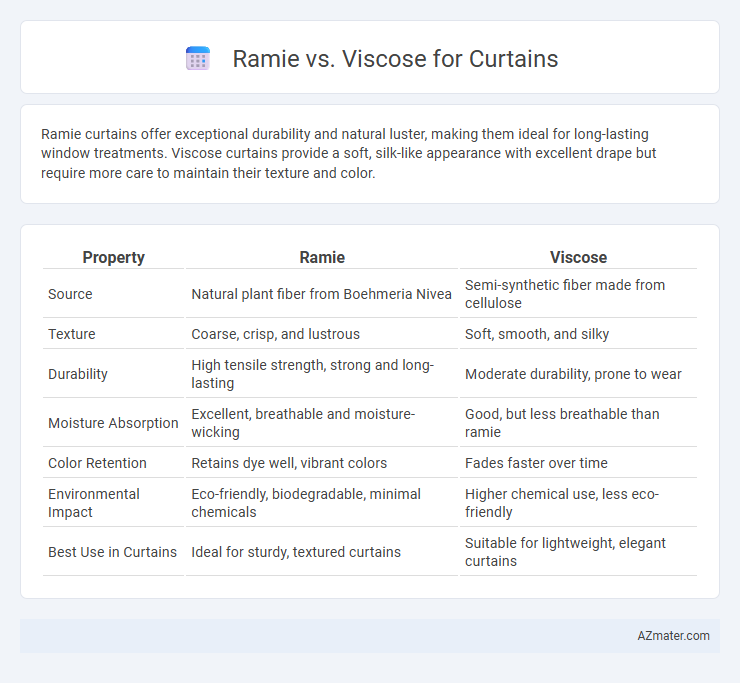Ramie curtains offer exceptional durability and natural luster, making them ideal for long-lasting window treatments. Viscose curtains provide a soft, silk-like appearance with excellent drape but require more care to maintain their texture and color.
Table of Comparison
| Property | Ramie | Viscose |
|---|---|---|
| Source | Natural plant fiber from Boehmeria Nivea | Semi-synthetic fiber made from cellulose |
| Texture | Coarse, crisp, and lustrous | Soft, smooth, and silky |
| Durability | High tensile strength, strong and long-lasting | Moderate durability, prone to wear |
| Moisture Absorption | Excellent, breathable and moisture-wicking | Good, but less breathable than ramie |
| Color Retention | Retains dye well, vibrant colors | Fades faster over time |
| Environmental Impact | Eco-friendly, biodegradable, minimal chemicals | Higher chemical use, less eco-friendly |
| Best Use in Curtains | Ideal for sturdy, textured curtains | Suitable for lightweight, elegant curtains |
Introduction to Ramie and Viscose Curtains
Ramie curtains, made from a natural bast fiber derived from the Ramie plant, offer exceptional durability, breathability, and a luxurious silky appearance ideal for elegant window treatments. Viscose curtains, produced from regenerated cellulose fibers, provide a smooth texture, vibrant color retention, and a soft drape that enhances the aesthetic appeal of interiors. Both materials deliver distinct benefits in terms of texture, longevity, and maintenance, influencing their suitability for various curtain styles and home environments.
Material Origins: Ramie vs Viscose
Ramie is a natural fiber derived from the stalks of the Chinese nettle plant, known for its strength and breathable qualities, making it ideal for durable, eco-friendly curtains. Viscose, a semi-synthetic fiber, is produced from chemically processed wood pulp, offering a silky texture and vibrant dye absorption but with less environmental sustainability. Choosing between Ramie and Viscose curtains depends on prioritizing natural fiber resilience versus smooth texture and color richness.
Durability Comparison: Which Lasts Longer?
Ramie fibers exhibit exceptional durability for curtains due to their strong cellulose composition and resistance to abrasion, often lasting significantly longer than viscose. In contrast, viscose, derived from regenerated cellulose, tends to weaken over time with exposure to moisture and sunlight, reducing its lifespan. For long-lasting curtains, ramie is the superior choice as it maintains its strength and appearance through years of use while viscose requires more frequent replacement.
Aesthetic Appeal: Texture and Color Vibrancy
Ramie curtains offer a natural luster and a coarse, textured surface that enhances rustic and organic interior styles, providing a subtle sheen that reflects light elegantly. Viscose curtains boast a smooth, silky texture with vibrant color intensity, maintaining a rich and consistent appearance that energizes contemporary and luxurious decors. The choice between Ramie and Viscose for curtain fabric depends on desired texture interplay and the depth of color vibrancy required for the room's overall aesthetic impact.
Breathability and Moisture Control
Ramie offers superior breathability and natural moisture-wicking properties, making it an excellent choice for curtains in humid environments. Viscose, while soft and drapable, tends to retain moisture longer, which can reduce airflow and lead to dampness over time. Choosing ramie curtains enhances airflow and maintains a fresher indoor atmosphere through effective moisture control.
Eco-Friendliness and Sustainability Factors
Ramie fibers, derived from the stalks of the Chinese nettle plant, are highly eco-friendly due to their renewable nature, minimal pesticide use, and biodegradability, making them a sustainable choice for curtains. Viscose, although made from cellulose, involves chemically intensive processing with significant water and energy consumption, raising concerns about its environmental impact despite being biodegradable. Choosing ramie curtains supports sustainable textile production through lower ecological footprints and reduced chemical waste compared to viscose alternatives.
Maintenance and Care Requirements
Ramie curtains require minimal maintenance due to their natural resistance to dirt and mildew, often needing only gentle hand washing or dry cleaning to preserve fabric strength and luster. Viscose curtains demand more delicate care, as they are prone to shrinking and losing shape, requiring cold water washes or professional dry cleaning to maintain texture and color vibrancy. Proper ironing on low heat is essential for ramie, while viscose benefits from steaming to avoid fiber damage and maintain curtain drape quality.
Cost Analysis: Ramie vs Viscose Curtains
Ramie curtains generally have a higher initial cost compared to viscose due to their natural durability and eco-friendly cultivation process. Viscose curtains, while more affordable upfront, may incur additional expenses over time because of their lower resistance to moisture and wear. Evaluating long-term usage and maintenance can highlight the overall cost-effectiveness of ramie versus viscose curtains.
Best Use Cases for Each Fabric
Ramie fabric, known for its strength and natural luster, excels in curtains requiring durability and a more textured, rustic appearance, making it ideal for living rooms and sunrooms with moderate sunlight. Viscose, a semi-synthetic fiber with a smooth finish and excellent drape, suits elegant, flowing curtains in bedrooms or formal spaces where softness and a silk-like aesthetic are desired. Choosing ramie enhances air circulation and longevity, while viscose offers rich color absorption and a luxurious feel for decorative window treatments.
Conclusion: Choosing the Right Curtain Material
Ramie curtains offer superior durability and natural luster, making them ideal for spaces that require a sturdy, eco-friendly fabric with a crisp appearance. Viscose curtains provide a softer, more luxurious drape with excellent color retention, suitable for rooms aiming for elegance and warmth. Selecting the right material depends on the desired balance between strength and softness, with ramie favored for heavy-duty use and viscose preferred for a refined aesthetic.

Infographic: Ramie vs Viscose for Curtain
 azmater.com
azmater.com